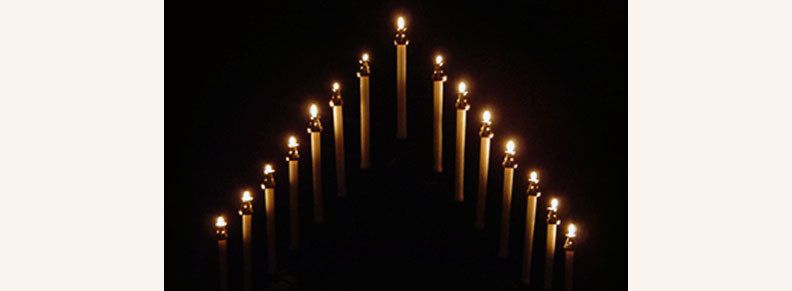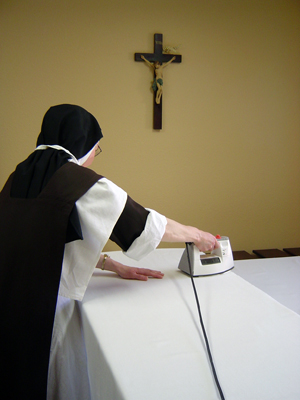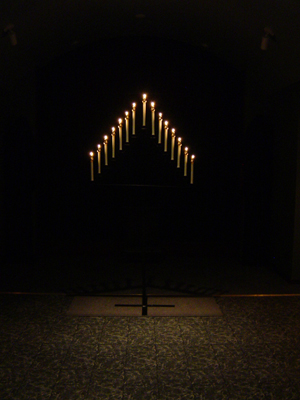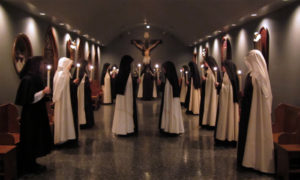
Carmelite Customs for Holy Week
Special Edition
Dear Friends of Carmel,
Our newsletter will be brief this time, as we are preparing with deepening silence and solitude for the holy days before us. We promised last time to tell you more about our daily life and hope that this description and pictures on our website of a day in Carmel will be of interest and give a better idea of what the Carmelite vocation is all about.
We promised, too, to share with you some of the customs of Carmel for the days of Holy Week. So many of these customs were instituted by Our Holy Mother St. Teresa herself and so are practiced with special veneration. The beautiful chants of the Church are an important part of all we do during these days.
One of the very moving customs of Holy Week is an act of reparation to Our Lord for the treacherous betrayal of Judas. An image of the Sacred Heart stands in the middle of the Choir. One Sister reads a brief meditation about the act of betrayal of the Son of God, and the Sisters listen in silent, loving attention. We recall and try to realize the sentiments of our Savior on the night before His death, when He faced the man whom He had called “friend”, and of whom He sadly stated, “It were better for that man if he had never been born.” The ceremony continuing then, the silence is broken by the chanting of the Miserere (Psalm 50). It is said that this is the Psalm that King David composed and prayed at the time of his great sin and penitent conversion. So it is with sentiments of reparation, but also confidence in mercy, that we contemplate this sorrowful event in Our Lord’s life: for Judas despaired of this mercy. We pray for the many souls in this world who are, perhaps, far from God and for those who struggle to believe in God’s tender mercies and love for them.


The monastic tradition of chanting Tenebrae is the custom we most treasure each year during the Sacred Triduum, or final three days of Holy Week. Tenebrae is the Latin word for “darkness” or “shadows” and is prayed in the early morning before it is light. The texts for these Hours of the Divine Office are composed of readings from the Prophets, passages from the Gospels and from the Epistles of St. Paul, and commentaries of St. Augustine. As the choir chants, the candles on the hearse (a triangular-shaped candelabrum) are extinguished, one by one, until only one remains: symbol of the “Deathless One”, Christ Our Lord Risen. The last remaining candle is hidden behind the altar, and in the darkness we pound on our choir stalls to make a din of noise. This final moving part of the Tenebrae ceremony, reminiscent of the upheaval of nature on Good Friday, expresses vividly the confusion and disorder caused by the death of the God-Man. The single lighted candle is then replaced on the hearse for all to contemplate.
We are, as each day passes, more drawn into the mystery of salvation, re-living its sorrow and its victory. The antiphon we chant at the very end of each day’s Tenebrae Office recalls and proclaims the sacrificial obedience which, in the Divine Plan, accomplished this great work of salvation. It is the Christus Antiphon, extended each day, from Holy Thursday to Holy Saturday: “Christ became obedient for us unto death,” on Holy Thursday; “…even unto the death of the Cross,” on Good Friday; “…Therefore God has exalted Him and given Him a name that is above every name,” on Holy Saturday. The haunting melodies of the Gregorian Chant for these holy days remain with us as we go about our other duties in preparation for the ceremonies and services of these days – the ironing of fresh linens for the altars, helping to clean the chapel, sending out Blessed Palm to religious communities who are in need, making bows for the lilies that will grace the altars on Easter Day!
We invite you to read excerpts from the revered Liturgical Year by Abbot Gueranger and other sources on our website to learn more about the Tenebrae ceremony and its symbolism.
We close this letter with assurance of our prayers for you as we together renew the Passion, Death and Resurrection of Our Savior. May the holy days of mourning lead us in more perfect faith and greater holiness to the joyous victory of the empty tomb!
Your Carmelite Sisters
